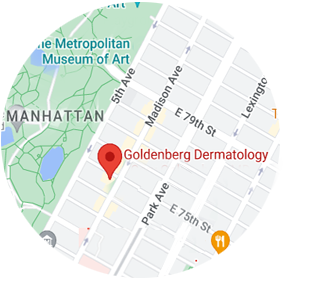

Pulsed dye laser (PDL) technology is an innovative non-invasive cosmetic treatment that can effectively address vascular abnormalities and certain pigmented and non-pigmented lesions. Pulsed laser technology is especially well-suited for the treatment of redness associated with acne and rosacea, angiomas (red growths), leg veins, scars and keloids, and brown pigmented lesions (lentigines). At his NYC office, cosmetic dermatologist Dr. Gary Goldenberg regularly uses the V-Beam pulsed dye laser device for his customized laser procedures. As a treatment, it offers precision and flexibility.

The VBeam Laser Technology
The V-Beam pulsed dye laser device utilizes a highly accurate technology to eradicate blood vessels. When employed, the V-Beam laser device emits a concentrated, yet gentle,beam of light energy to the treatment area, which in turn generates heat. When the thermal output reaches the targeted blood vessels, it destroys them. As a result, red pigmentation is reduced. Because the V-Beam is so precise, the intense burst of light it emits can selectively eliminate the damaged blood vessels—without harming the surrounding skin and tissues. V-Beam is suitable for cosmetically sensitive areas, including the face, neck, and V of the chest. To ensure the most efficient treatment and optimize results, Dr. Goldenberg will adjust the settings of the V-Beam device according to the specific condition being treated.
What to Expect During V-Beam Treatment
V-Beam is essentially a pain-free procedure and does not require general anesthesia. However, prior to delivering pulses of laser light, Dr. Goldenberg will apply a topical cooling agent (cryogen) to the skin to minimize discomfort. As the laser light penetrates the skin, patients typically feel a heating sensation. A single V-Beam appointment can last from 15 minutes to 2 hours, depending on the extent of the skin irregularities and the size of the area being treated. More than one session is usually necessary to achieve optimal results.
After the V-Beam Treatment
V-Beam pulsed dye laser treatment is considered safe, presenting few risks and complications. VBeam is non-ablative laser treatment, which means that surface tissue will not be vaporized during the procedure. Because of this, recovery time is minimal and patients often return to their normal activities immediately. Following treatment, most patients experience some tenderness, swelling, bruising and/or redness, which can be concealed with makeup. These minor symptoms generally fade within a day. For a few days after V beam, you should avoid excessive exposure to sunlight. In addition, Dr. Goldenberg recommends using SPF 30-50 sunscreen immediately after the V-Beam procedure. If you have a tendency to develop cold sores, please tell Dr. Goldenberg so that he can prescribe preventive medication.
New York-based Dr. Goldenberg specializes in state-of-the-art laser treatments, including VBeam pulsed dye laser. If you are in the NY area and would like to correct your vascular or pigmentation imperfections, contact us at our office to schedule a consultation. Dr. Goldenberg will recommend a personalized treatment plan that can help you achieve your cosmetic objectives.
For more information about the V-Beam laser, click here.
What is V-Beam?
V-Beam is a pulsed dye laser (PDL) device that can be used to reduce skin discoloration treat vascular irregularities, such as broken capillaries, and pigmented and certain non-pigmented lesions. Dr. Gary Goldenberg, a New York board certified cosmetic surgeon and specialist in non-invasive cosmetic treatments, offers VBeam at his NYC office.
How does V-Beam work?
VBeam delivers an intense pulse of light to the dermis, which is absorbed as heat energy by the blood vessels associated with the skin blemish. As a result, these blood vessels are destroyed and, subsequently, eliminated via the body’s own waste removal mechanisms. VBeam lasers are non-ablative, which means that they leave the surface of the skin intact. In addition, the VBeam is a highly precise, ensuring that surrounding tissue is not damaged. This translates to little to no downtime and a lower risk of side effects and complications.
What does V-Beam treat?
Because the VBeam laser emits light wavelengths that are readily absorbed by the color red, it can hone in on damaged blood vessels and remove them. This makes it an extremely effective treatment for clearing up vascular skin conditions that cause redness. Dr. Goldenberg uses VBeam to address a range of skin irregularities, including rosacea, port wine stains, redness resulting from acne, facial and leg veins, scars, and angiomas.VBeam can improve the overall tone and texture of the skin, making it an option for those wishing to reverse the effects of sun damage or rejuvenate the skin.
What happens during a V-Beam treatment?
The non-invasive VBeam treatment is relatively painless and general anesthesia is not needed. With a built-in skin cooling device, the non-invasive VBeam system is designed to optimize patient comfort. To minimize patient discomfort, the VBeam cooling device can spray a topical cooling agent (cryogen) on the skin prior to delivering each pulse of laser light. Patients typically feel a mild heating sensation as the light energy enters the skin. Dr. Goldenberg may apply a topical anesthetic cream, if necessary. A Vbeam session can be done in as little as 15-20 minutes. However, the total treatment time will depend on the condition of the area being treated.
How many treatments are necessary?
The exact number of treatments necessary to achieve optimal results will vary from individual to individual. However, more than one session is usually necessary (typically between 4 and 6, performed every six weeks).
Are there side effects associated with V-Beam?
VBeam is considered safe and poses very few risks. The most common side effects include mild redness and swelling around the treatment area. However, these symptoms tend to be minor and should subside within a matter of days.
Am I a good candidate for V-Beam?
If you are generally healthy and have a skin discoloration or blemishes caused by damaged blood vessels, you may be a good candidate for VBeam. VBeam is not appropriate for individuals with dark skin. If you have a poor blood circulation or diabetes, you should not undergo the procedure. During your consultation, Dr. Goldenberg will review your medical history and determine whether VBeam is appropriate for you.
If you are in the NY area and are interested in VBeam laser treatments, contact Dr. Goldenberg at his NYC office.













